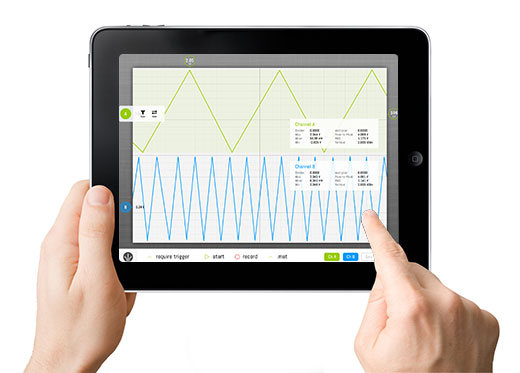

- #SMARTSCOPE OSCILLOSCOPE HOW TO#
- #SMARTSCOPE OSCILLOSCOPE SOFTWARE#
- #SMARTSCOPE OSCILLOSCOPE PROFESSIONAL#
One of my local Facebook friends offered to lend me her LabNation SmartScope, and that turned out to be perfect for my needs.


But the available space on my desk is barely more than one foot square, and I also wanted a signal generator. Many people posted links to their favorite models, and several others insisted that all USB oscilloscopes are awful and I’d never be happy unless I bought a real hardware oscilloscope. I’ve seen ads for USB oscilloscopes with megahertz bandwidths, so on my Facebook page, I asked for recommendations of two-channel USB oscilloscopes costing no more than a few hundred dollars. Photo 1: The LabNation SmartScope ships with the two probes, a 24” USB A/Mini-B interface cable, a 10 conductor ribbon cable, nine grabbers, and cables for eight-channel digital signal analysis. But even with a sound card set to sample at 192 kHz, there’s no way to see if radio interference is getting into your circuit, or to tell if an op-amp is oscillating at megahertz frequencies. You can also buy or build accessories that turn a USB sound card into an oscilloscope suitable for audio testing. You can zoom in to see the waveforms at any level of detail, and even show the spectrum as an FFT graph. I’ve done a lot of signal analysis just recording into Sound Forge - the audio editor program I use. I have a good digital multimeter, but it was time to buy an oscilloscope. Hopefully, that will be the subject of a future audioXpress article! I still have engineer friends with workshops and real test gear, but eventually I got tired of driving half an hour every time I wanted to troubleshoot the latest developments of my device. Now, fast forward to the present when I started developing a new and unique type of audio testing device.
#SMARTSCOPE OSCILLOSCOPE SOFTWARE#
Between Leo and whatever electronics company for which I currently worked, I always had access to everything I needed.Įventually I developed other interests - by 1980, I built and was running a large commercial recording studio, then a software company, then I started playing the cello and composing classical music, plus other non-electronic projects.
#SMARTSCOPE OSCILLOSCOPE PROFESSIONAL#
But I never bought any professional test gear myself. Leo’s test bench included state-of-the art oscilloscopes, signal generators, real-time audio analyzers, and even a distortion analyzer. Leo had all the latest HP test gear, which we used to design several analog synths. By the 1970s, I had designed and built equalizers, compressors, analog synthesizers, and even an entire 16-channel recording and mixing console.Īt one of my technician jobs, I had the good fortune to befriend Leo Taylor, who later was a senior tech at a nearby Hewlett-Packard (HP) repair facility. I asked them endless questions, and learned a lot. I never got a degree or even went to school for electronics, but I worked as a technician with many excellent “real” engineers.
#SMARTSCOPE OSCILLOSCOPE HOW TO#
Knowing how to use audio gear effectively is great fun, but for me understanding how audio devices actually work is even more fun. That drove my desire to get a tape recorder, and eventually it also drove my lifetime goal of learning all about audio and recording, developing a keen interest in analog circuit design along the way.


 0 kommentar(er)
0 kommentar(er)
